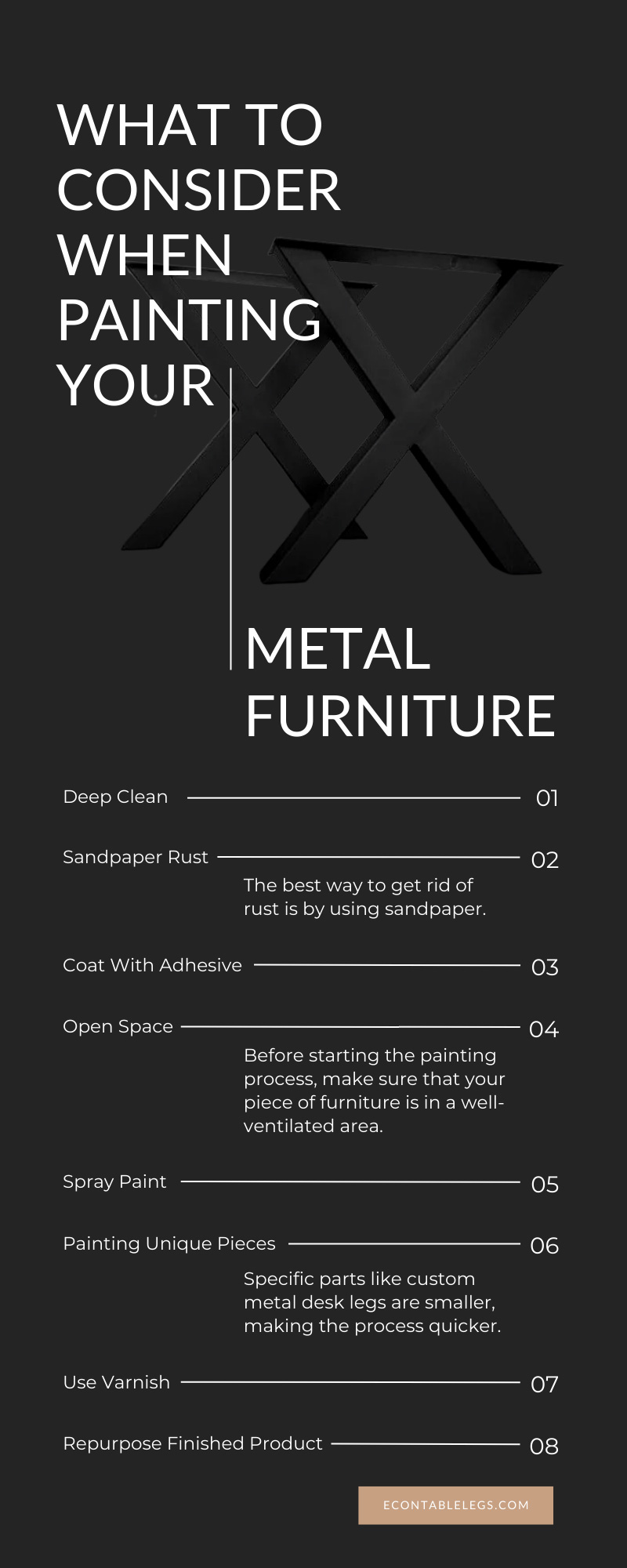What To Consider When Painting Your Metal Furniture
Should you Paint your Metal Furniture?
Turning metal furniture into something that looks new has a lot of great benefits. If you have an old piece of furniture that is still functional but is not very visually attractive after years of use, a good option is to give it a fresh coat of paint. Buying new furniture may be exciting—but giving what you already have a second chance and the ability to shine is unique.
If you decide to upgrade your existing metal furniture and transform it, here are some tips on what to consider when painting your metal furniture to get better results and make the most out of it. It is an easy process, and there are some points to consider that work for most metal pieces.
Deep Clean
If the piece of furniture you want to transform is inside your home, you first need to clean it with a brush to remove any dust that usually accumulates in the intersections of the metal. Next, use a wet cloth or a wet sponge and a couple of drops of soap to clean the metal. After gently washing your furniture, let it air dry completely.
Outside furniture requires a deeper cleaning because of the exposure to different elements like dirt, mud, and debris. For these, you can use a power washer for a deep clean, spray every inch and then let it air dry.
Sandpaper Rust
Metal tends to get rusty, and the rust can slowly eat at the metal. The best way to get rid of rust is by using sandpaper. After washing your furniture, use sandpaper to scrape any visible rust first and then go all over your piece. If you paint over rust, it will eventually fall off with your paint, creating tiny spots that may ruin the complete look.
The sandpaper will eliminate any little pieces of metal that stick out or are about to fall off. If a significant portion of your furniture has rust, has holes, or is about to fall off, it is a good idea to first fix that area before painting. Depending on the situation, you can weld a smaller piece or fill it with caulk.
Coat With Adhesive
After you have cleaned, washed, and sandpapered your furniture, you need to add adhesive. This will keep everything in place and will give the paint a more uniform surface to work with. The adhesive will also ensure that the fresh coat of paint sticks all over without any bubbles. This product comes in a spray bottle for easy use and will make the process go quick and smooth.
Open Space
Before starting the painting process, make sure that your piece of furniture is in a well-ventilated area, as the smell of paint is strong and inhaling it for a long time is bad for your health. Also, painting is messy, so you don’t want to paint over wooden floors or close to white walls because there is a big chance that you might be getting some stains. No matter how careful you are, paint finds a way to leave a mark.
If you have limited options for spaces where you can paint, you can also cover your walls, floors, and doors with plastic covers, tape, or cloths to ensure that the paint doesn’t go any further. Those elements are easy to use and remove; you can also recycle them and keep them for future projects.
Spray Paint
The traditional way of painting with a brush is effective and lets you manipulate paint to use as much paint as you want, but it is sometimes hard to get too deep and into small crevices. Spray paint is an excellent option because it cuts down your time almost in half and allows you to cover every single inch with paint.
Make sure to give your can a good shake to ensure that the color is well-mixed and ready to go. Try spraying left to right with a spray can; this will cover a larger area and leave a uniform coat. After the first coat, wait around 1 hour, add the second one, let it dry overnight, and check if that is the shade you were aiming for.
There are many different colors and shades you can choose from that come in a can ready to go. Traditional paint lets you create a specific shade and color, while the paint that comes inside of a can doesn’t change.
Painting Unique Pieces
If you have a custom-made piece of metal furniture or metal details for dining tables or bedroom frames, you can ask your provider what the best options are for paint and if they could do it for you. Specific parts like custom metal desk legs are smaller, making the process quicker.
Professionals can take care of this in no time, and they have the necessary tools to do it without you having to take your bed out to the patio. When furniture is inside the house or a room, the result will transform the look with simple and subtle details.
Use Varnish
After painting and leaving your furniture to dry overnight and accomplishing the desired tone and shade, use varnish to finish the process. This will make the furniture look finished and shiny while giving the paint a coat to strengthen its resistance. If your furniture is for the exterior, it will make it waterproof, and dust will not stick easily.
This last step is important to consider when painting your metal furniture. Apply varnish the same way you applied the paint, evenly distributed side to side if it’s with a spray can. For the traditional way, try using small amounts of varnish and spread it all over evenly. Make sure to also avoid creating bubbles and uneven proportions.
Repurpose Finished Product
A table with freshly painted legs could become your next dining room table; a smaller pedestal table could go from a bar table to a beautiful new tv stand. Repurposing and rethinking possibilities are also part of the process that comes from painting and giving a new life and look to metal furniture.
Once you finish your first project, you will notice a big difference and change, encouraging you to do more and giving new life to old furniture. This might even get you to try using more metal details that will enhance the uniqueness and beauty of your home.


